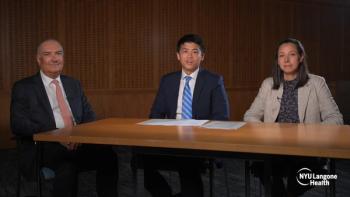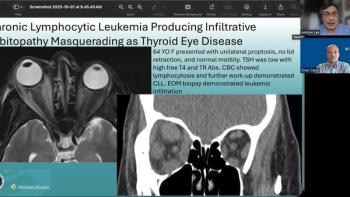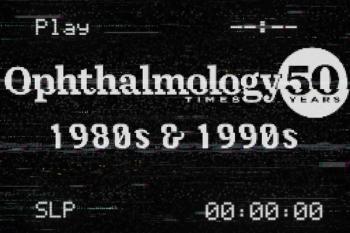
- Ophthalmology Times: November 1, 2020
- Volume 45
- Issue 18
Good nutrition optimizes ocular surface in premium cataract patients
Improvements gained prior to surgery can result in positive outcomes.
Special to Ophthalmology Times®
Undetected and untreated, signs and symptoms can cause significant variability in preoperative measurements as well as inhibit rapid healing following surgery.
Thoroughly screening and potentially treating patients for
Related:
Ocular surface assessment
Every patient undergoes a comprehensive evaluation as part of the cataract consultation. I use a variety of subjective and objective diagnostic tests to identify
All patients receive corneal fluorescein and lissamine green staining, and they also are tested for inflammation levels.
Where the tear film is unstable, I watch for conjunctivochalasis or entropion and ectropion. Dropout areas, irregular topography, measurement inconsistencies, and abnormalities in tear film tests all can signal
Typically, I will see a patient back in 3 weeks and repeat testing. Using comparative topographies, I confirm corneal stabilization so that the patient and I are comfortable with the measurements.
I also look at the surface asymmetry index, which tells me how asymmetric the corneal astigmatism is, and at the surface regularity index. These provide me the topographic standpoint of the cornea and guide me if I should move forward.
Related:
I also look at how the numbers change in response to treatment. For example, I will look at the change in Ks. Once we see 0.25 D or less between measurements, I am satisfied that the ocular surface is stable and we can proceed to surgery.
Treatment for all
As part of my approach to optimizing the ocular surface before cataract surgery and to improve comfort postop, I require all premium lens patients to start taking a nutritional supplement containing the anti-inflammatory omega fatty acid GLA and other nutrients after their first measurement.
I also recommend HydroEye (ScienceBased Health) because it demonstrated in a clinical trial increased corneal smoothness, decreased inflammation, and improvement in the symptoms of
For patients requiring treatment beyond nutritional supplementation, topical immunomodulators, such as lifitegrast or cyclosporine, are usually well tolerated and produce long-term improvements in the ocular surface.
Related:
In eyes with significant levels of inflammation, patients may benefit from a brief treatment with a corticosteroid. In addition, punctal occlusion may be utilized to address aqueous tear deficiency.
Patients with crusting blepharitis undergo mechanical debridement, short-term antibiotics, hypochlorous acid treatments, or a combination of these to remove inflammation-causing bacteria on the eyelid.
Once patients have been taking nutritional supplementation for 2 weeks and any other necessary
Two weeks following the second surgery, I give patients the option to taper down the supplement and see if their eyes continue to be without symptoms.
Related:
Many of my patients with
Be willing to wait
When patients understand that we need a healthy ocular surface in its natural shape to get the best surgical outcome, they rarely push back. Symptomatic patients are especially understanding. They are experiencing irritation and visual fluctuations and recognize that this is a consequence of degradation, not cataract. Overall, patients want the best results.
The “wow” factor
Patients with premium lenses have high expectations, and failure to deliver can stir up frustration. Managing the ocular surface on the front end is key to producing a “wow” factor postoperatively.
Related:
First, eliminating residual refractive error is essential when using any multifocal IOL. I always measure the cornea 4 ways, and, ideally, the numbers will coincide.
In patients with
Even without residual refractive error, ocular surface discomfort and visual fluctuations can create general health anxiety that may shape the patient’s perceptions about the procedure.
By taking precautions to ensure the cornea is in optimal condition prior to surgery, we can create a more resilient ocular surface and reduce postoperative keratopathy and negative visual fluctuations.
Related:
A proactive approach delivers the best outcomes
Proactively optimizing the ocular surface through a combination of nutraceutical supplementation and topical drop therapies such as lifitegrast or cyclosporine gives me more confidence in the preoperative measurements, leading to better results and patient satisfaction with their premium procedures.
In conclusion, it is a very dramatic effect when a patient experiences quality vision on day 1, and by day 5 they are able to read off their phone in low light.
About the author
William Segal, MD
e:[email protected]
Segal is in private practice with Georgia Eye Physicians and Surgeons in Duluth.
--
Reference
1. Sheppard JD, Singh R, McClellan AJ, et al. Long-term supplementation with n-6 and n-3 PUFAs improves moderate-to-severe keratoconjunctivitis sicca: a randomized double-blind clinical trial. Cornea. 2013;32(10):1297-1304. doi:10.1097/ICO.0b013e318299549c
Articles in this issue
almost 5 years ago
Investigators study home-based monitoring for exudative AMDalmost 5 years ago
Ocular gene therapy offers hope for inherited retinal diseasealmost 5 years ago
Extended depth-of-field IOLs: Clarifying current nomenclaturealmost 5 years ago
Investigators show long-term visual declines in DME eyesalmost 5 years ago
Developing retinal technologies strengthen visualizationalmost 5 years ago
Building a brand is key to developing successful practicealmost 5 years ago
Changing patient conversations around cataract surgeryalmost 5 years ago
Planning is important — even when “nobody knows nothing”Newsletter
Don’t miss out—get Ophthalmology Times updates on the latest clinical advancements and expert interviews, straight to your inbox.





















































.png)


